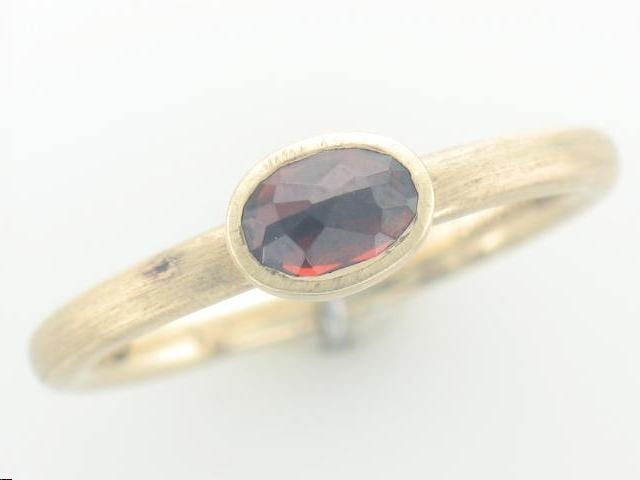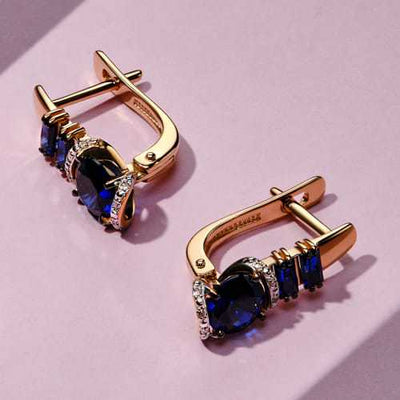Garnet gemstones are unique in the fact that they are available in almost every color. The mineral group that garnet belongs to includes numerous stones, including Andradite, Rhodolite, and Pyrope. These beautiful stones are the birthstone for January, and they are a fairly popular gemstone choice in fine jewelry. Noe’s Jewelry’s guide on Garnet will explain everything you need to know about these precious gems.
What is a Garnet?
Garnets are a single type of stone. Instead, garnet is a family of different stones, and it is one of the most complex gems in the world because of this fact. There are several different species and varieties of garnet.
This means that there is no single chemical composition for garnets. Generally, garnets are formed with silica and oxygen, as well as a variety of other elements that create the various different species and specific stones.
Types of Garnets
 Garnets are usually associated with the color red, and many garnets are red. However, garnet can come in almost any color. There are more than 20 different species of garnet, but only six are used as gems:
Garnets are usually associated with the color red, and many garnets are red. However, garnet can come in almost any color. There are more than 20 different species of garnet, but only six are used as gems:
- Pyrope: Chrome pyrope garnets are bright red like rubies. They are very dark in tone.
- Almandine: This species is the most common gemstone in the garnet family. Almandine gems come in a wide range of colors. An almandine-pyrope blend forms the dark red color that we commonly associate with garnets. You may also see these garnets under the name almandite.
- Spessartine: Also known as spessartite, these garnets are somewhat rare and come in orangey tones. Mandarin garnets, in particular, are highly sought after.
- Grossular: Grossular garnets are rarely red or dark. They can be found in every color including colorless, except blue. They are great gemstones for jewelry due to their light to medium tones and vibrant colors.
- Andradite: Andradite garnets are some of the rarest. They have the highest dispersion of all garnets, and they have even more fire than diamonds. Demantoids are a variety of andradites that are highly prized for their green color.
- Uvarovite: These green garnets are generally too small to cut, but they are sometimes set as clusters in pieces of jewelry. These are the rarest stones in the garnet family. Their dark green color rivals that of an emerald.
Garnets can also be blends. The following are not actually sub-varieties, but are instead considered garnet blends:
- Rhodolite: This is a blend of pyrope and almandine garnets with a distinctive purple hue.
- Malaia: Originally used a describe garnets that didn’t fit into standard categories, malaia garnets are now considered a blend of pyrope and spessartite.
- Color change garnets: These are newly discovered garnets that turn blue in artificial light. They are a pyrope-spessartite blend when they are blue garnets that have red and purple flashes under incandescent light found in Madagascar. Garnets that shift from red to purplish red from Idaho are a blend of almandine and pyrope.
Where Are Garnets Found?
Like many other gemstones, garnets can be mined from many parts of the world. During the Victorian times, Bohemia was the primary source for garnets. By the 19th century, Russia was mining green garnets from the Ural Mountains.
Now, Africa is responsible for most of the garnets on the market. Namibia is known for green demantoids, while Kenya, Madagascar, and Tanzania produce a lot of the bright green tsavorites we see in jewelry stores. Orange-to-yellow spessartine garnets are often found in Namibia and Tanzania, as well.
In the United States, California has produced garnets in the past. These garnets were found in Southern California’s Little Three mining area.
Garnets can also be found in Brazil, Iran, India, Myanmar, Afghanistan, Pakistan, and Sri Lanka.
4 C’s for Garnets

Like the other gemstones, there is a grading scale for garnets. In the jewelry industry, these are called the 4 Cs.
Color
For garnets, color is the most important quality factor. Since there are so many different color options, this can really help buyers determine what color of garnet that they are interested in.Clarity
The clarity of garnets refers to the inclusions in the gems. Clarity grades are dependent on garnet type. For example, red garnets generally do not have eye-visible inclusions, while some orange garnets often do.Cut
The way a garnet is cut can dramatically impact the way the gemstone looks in jewelry. Since appearance is an important element, different cuts are crucial to attract buyers of all styles. Additionally, garnets are generally cut into shapes that result in the least amount of waste.Carat
Carat weight tells buyers how much the gemstone weights. While garnets can be found in all sizes and weights, large carat weights are often rare, which contributes to higher prices.Caring for Garnets
To clean a garnet, you should use only warm water, detergent, and a soft brush. Even though garnets are relatively hard stones, they can be sensitive to heat. Extreme heat should be avoided.
If you are interested in purchasing a garnet, look no further than Noe’s Jewelry. Located in Raymore, Missouri, our showroom displays some of the most beautiful garnets in the market. Contact us today at 816-322-7227.
Check out the other stones in our Gemstone Series Guides:





